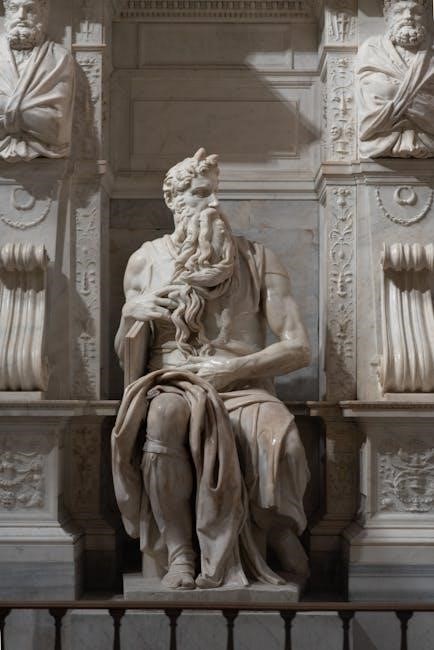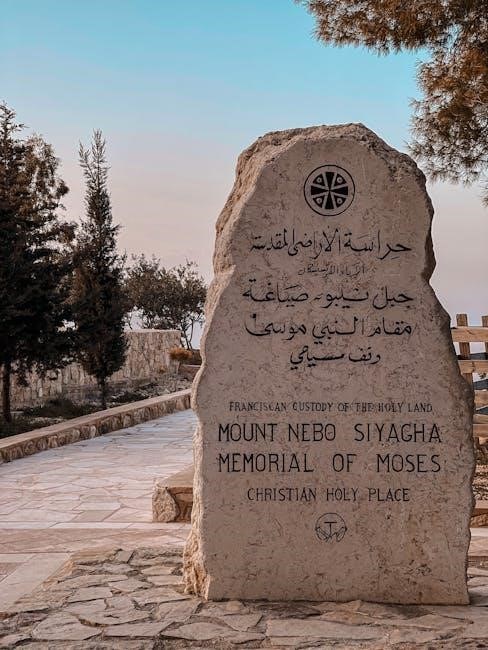
The Testament of Moses, a Jewish apocryphal text, presents Moses’ farewell address to Joshua, filled with prophecies about Israel’s future, divine judgment, and redemption, preserved in a Latin manuscript.
1.1 Historical Context and Background
The Testament of Moses, an ancient Jewish apocryphal text, is believed to have been written in the 1st century CE. It is part of the Jewish pseudepigrapha, offering insights into the religious and cultural milieu of the late Second Temple period. The text is structured as Moses’ farewell speech to Joshua, drawing parallels with Deuteronomy 31-34. Scholars, such as James C. VanderKam, note that its prophecies extend into the 1st century CE, indicating it was composed after that time. The original text was likely written in Hebrew, but only a Latin manuscript survives, which is incomplete. This work is classified as a “testament,” emphasizing Moses’ prophetic role and his final address before his death. Its historical significance lies in its theological themes and its influence on both Jewish and early Christian thought, making it a valuable resource for understanding ancient religious traditions.
1.2 Structure and Content of the Testament
The Testament of Moses is structured as a farewell address from Moses to Joshua, outlining Israel’s future and divine plans. It begins with Moses’ final instructions in the 120th year of his life, corresponding to the 2,500th year since creation. The text includes prophecies about Israel’s history, emphasizing divine judgment for sin and eventual redemption. Key themes include the destruction of idols, the punishment of Gentiles, and the exaltation of the faithful. The surviving Latin manuscript is incomplete, ending abruptly, but scholars believe it originally concluded with Moses’ death and assumption. The content reflects a blend of apocalyptic and testamentary genres, offering a unique perspective on Jewish eschatology and the role of Moses as a prophetic figure. Its structure and content provide a theological framework for understanding Israel’s covenantal relationship with God.

Theological and Thematic Elements
The Testament of Moses explores themes of divine judgment, redemption, and covenant fidelity, emphasizing God’s sovereignty and Israel’s role in His plan, blending apocalyptic visions with moral exhortations.
2.1 Prophecies and Divine Judgment
The Testament of Moses is rich in prophecies about Israel’s future, blending divine judgment with promises of redemption. It foretells periods of suffering and oppression, followed by ultimate deliverance. The text emphasizes God’s sovereignty and justice, warning of retribution for disobedience while promising mercy to the faithful. Moses’ prophecies extend into the first century CE, reflecting a historical context of persecution and hope. The manuscript, though incomplete, highlights themes of divine intervention and the ultimate triumph of God’s plan. Scholars like James C. VanderKam note the text’s apocalyptic tone, linking it to broader Jewish apocalyptic literature. These prophecies serve as both warnings and assurances, reinforcing Israel’s covenantal identity and divine destiny.
2.2 Redemption and the Covenant
The Testament of Moses emphasizes redemption as a central theme, intertwined with Israel’s covenantal relationship with God. Moses’ prophecies outline a future marked by both divine judgment and ultimate deliverance, reinforcing the idea of God’s faithfulness to His people. The text underscores the covenant as a sacred bond, promising redemption to those who remain faithful despite adversity. Scholars note that the manuscript reflects a theology of hope, where suffering is not permanent but precedes divine intervention. The covenant serves as both a reminder of obligations and a promise of salvation. This duality of judgment and redemption highlights the text’s apocalyptic character, offering assurance to Israel of their eventual restoration. The Testament of Moses thus becomes a powerful expression of Jewish theology, blending eschatological hope with covenantal fidelity.

Availability and Access to the Testament of Moses PDF
The Testament of Moses PDF is widely available on platforms like Open Library and Scribd, offering free access to this Jewish pseudepigrapha in multiple formats.
3.1 Platforms for Downloading the PDF
The Testament of Moses PDF can be accessed through various online platforms. Scribd, one of the largest social reading platforms, offers free downloads in PDF, .odt, and .txt formats. Open Library, with its extensive collection of over 1 million eBooks, also provides free access to this text. Additionally, academic repositories and religious websites often host the PDF for educational purposes. Users can search for “The Testament of Moses PDF” on platforms like Google Scholar or university databases to find reliable sources. These platforms ensure easy access to the text, enabling readers to explore its historical and theological significance. Always verify the source for accuracy and completeness when downloading.
3.2 Key Features of the PDF Version
The PDF version of the Testament of Moses offers several key features that enhance readability and accessibility. It is universally compatible with various devices, ensuring easy access on smartphones, tablets, and computers. The text is well-formatted, maintaining the original structure and theological integrity of the manuscript. Many PDF versions include introductions, annotations, and historical context, providing deeper insights for readers. Additionally, the PDF is often free to download, making it accessible to a broad audience. Platforms like Scribd and Open Library provide high-quality versions with clear typography and navigation. Some editions also include bookmarks and search functions, allowing readers to quickly locate specific passages or themes. These features make the PDF an ideal resource for both scholarly research and personal study of this ancient text.

Scholarly Analysis and Interpretation
Scholars like John J. Collins and James C. VanderKam analyze the Testament of Moses, emphasizing its prophetic themes and historical context, comparing it to apocalyptic literature like Enoch and Daniel.
4.1 Comparative Analysis with Other Apocalyptic Literature
The Testament of Moses is often compared to other apocalyptic texts like the Book of Enoch and Daniel, sharing themes of divine judgment, redemption, and prophetic visions. Scholars note similarities in its eschatological outlook, emphasizing God’s ultimate triumph over evil. The text’s structure, blending prophecy with historical reflection, parallels works like the Apocalypse of Baruch. However, its focus on Moses as a central figure distinguishes it, blending Torah traditions with apocalyptic imagery. This comparative analysis highlights the Testament of Moses as a unique yet representative work within the broader genre of Jewish apocalyptic literature, offering insights into the theological and cultural currents of its time.
4.2 The Role of Moses as a Prophetic Figure
Moses emerges in the Testament as a central prophetic figure, bridging the past and future of Israel. His farewell address to Joshua is laden with divine revelations, emphasizing his role as a mediator of God’s will. The text portrays Moses as a prophet whose insights transcend time, foreseeing Israel’s struggles and ultimate redemption. His teachings blend ethical exhortations with apocalyptic visions, underscoring the inevitability of divine judgment and the triumph of righteousness. This portrayal aligns with broader Jewish traditions, where Moses is often depicted as the archetype of prophetic leadership. The Testament of Moses thus reinforces his legacy as a pivotal figure in shaping Israel’s spiritual identity, offering a unique lens through which to view the intersection of prophecy and history.

Cultural and Historical Significance
The Testament of Moses significantly influenced Jewish and Christian theology, offering insights into divine judgment and redemption, while its themes are revisited in modern media and literature.
5.1 Influence on Jewish and Christian Thought
The Testament of Moses has profoundly shaped Jewish and Christian theology, offering insights into divine judgment, redemption, and the covenant. Its prophecies about Israel’s future resonated deeply, influencing religious thought and eschatological expectations. The text’s themes of divine retribution and ultimate redemption align with central tenets of both traditions, making it a valuable resource for understanding the evolution of religious ideas. Its portrayal of Moses as a prophetic figure reinforced his significance in both faiths. Moreover, the text’s emphasis on covenant fidelity and divine sovereignty provided a theological framework that continues to inspire reflection. As a result, the Testament of Moses remains a crucial text for scholars studying the intersection of Jewish and Christian thought during the late Second Temple period.
5.2 Depictions in Modern Media and Literature
The Testament of Moses has inspired various modern interpretations in media and literature, blending historical narratives with contemporary storytelling. For instance, Netflix’s docudrama Testament: The Story of Moses delves into Moses’ life, incorporating themes from the text to explore his personal struggles and prophetic role. The series weaves biblical accounts with extra-biblical perspectives, sparking both intrigue and controversy. Additionally, the Testament’s apocalyptic imagery and prophetic tone have influenced literary works, where authors draw parallels between ancient prophecies and modern existential themes. These adaptations highlight the enduring relevance of the text, bridging ancient traditions with current cultural and religious discourse. Through such depictions, the Testament of Moses continues to captivate audiences, offering a fresh lens to explore its timeless messages. Its influence underscores the text’s adaptability and its ability to resonate across generations.